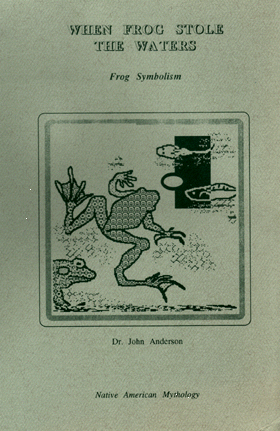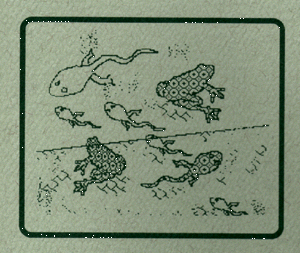A book by DR. JOHN M. ANDERSON
"My interest in John's books connects with my work as a story teller. His writings help me to 'think' about Chumash folk tales from new perspectives. I am especially pleased with this new book, because it brings forward the rich symbolism of the frog in native California lore."
And story teller in Santa Barbara schools, Southern California
This book "takes the reader on an exciting adventure into the field of Native American folklore. Following the tradition of Joseph Campbell and John Peabody Harrington, Anderson draws from a wealth of authentic stories, legends, and oral histories recorded from respected tribal elders.
Everyone should read for themselves and their children the folklore series of Dr. John Anderson. This book delves into the symbolism of ancient frog stores from around the world. Like a skipping stone, the reader is whisked away to savor legendary samplings from California, Washington, and Oregon, as well as along the Atlantic seabord and across the water in Europe. His multicultural approach helps people share in a greater sense of global heritage."
 "After reading this selection of Frog narratives, the reader cannot help but be impressed with the primary importance of the Frog in native American folk lore.
"After reading this selection of Frog narratives, the reader cannot help but be impressed with the primary importance of the Frog in native American folk lore.
Repeatedly in these tales, the frog (or a water demon with frog-like characteristics) was depicted as the guardian of all the fresh water in the springs and wetlands of the world. Often the frog was called Frog Woman. When all was going well, she was honored and respected. But in times of severe drought, Frog Woman (or her male counterpart) was demonized and Coyote, or some other cultural hero, challenged her. In almost all these tales, however, the hero could not get the Frog (as the water monster) to move, i.e. he could neither displace her physically nor emotionally. She remains unsympathetic and immo0bile, in spite of the hero's pleas for mercy.
Eventually the hero discovered that Frog held the fresh waters back by weaving, either a basket or a dam. He saved humans from dying of thirst by destroying the basket or dam, or in some cases by stabbing the demon's bloated stomach which substituted symbolically for a dam. In a number of tales, Coyote stole the fresh waters by drinking large amounts of water. Soon he became equally bloated and was released from his self-inflicted suffering only after someone else burst his stomach.
With the destruction of the dam, the impounded fresh waters were released in a flood. The rushing waves carved out a new landscape and also dispersed a plethora of wetland animals which thereafter became food for humans. In their fecundity, the impounded waters were thus similar to the European Cornucopia, the horn of plenty which fed the world and brought joy to both the gods and humanity.
... the Frog remains the preeminent native American symbol celebrating the fecundity of quiet wetlands. And in this role she is also associated with human pregnancy, whereby the female impounds fertile waters in the womb. When the water sack bursts, the rushing waters precede the birthing of the child, thereby reenacting the mythic events celebrated in the Frog tales. The mythic age comes to an end with the transformation of the landscape, the transmorphing of the First People into the food animals of the modern world.
Yet, after all these changes the Frog dwells in the backwaters, sitting on a log or lily pad and catching her food with her long tongue without moving her body. She thus demonstrates her supernatural association with the non-moving North Star, which teaches the virtues of humility and patience." (page 26).
 Unpopular Frogs "If an award was given for the most admired animal-of-the-year, few Americans would rush forward to champion the lowly frog for such an honor.
Unpopular Frogs "If an award was given for the most admired animal-of-the-year, few Americans would rush forward to champion the lowly frog for such an honor.
These inobtrusive amphibians have slimy skins, no tails, long awkward legs which flail out during their seemingly inefficient swimming. To make matters worst, they call out in the night in a percussive croaking voice which few listeners appreciate when they are trying to fall asleep" (footnote 1, page 28).
Frog "Smooth skinned, long tongued amphibians. They have protruding eyes and are predominantly aquatic. In native mythology frogs often control fresh water sources, such as springs and wetlands..... Frogs are active at night, when humans are asleep. In many native American folk tales Frog hoards the world's waters and causes much suffering among humans (drought)"(from the glossary, page 36).
Water Guardian "Native Americans, like Europeans, believed in many types of water guardians 9or spirits)as in the protectors of springs, lakes, and rivers. Frog Woman was "queen of the waters" in Chumash myths.... The Salamander, called the Water Dog by American ethnographers, is also a common water guardian in native myths, as were Snakes in rivers" (from the glossary, page 39).
Tribes Mentioned in the Text "Chapter one features a Kootenai Indian frog story. The following chapters discuss related narratives from the Pomo (California), Chumash (California), Algonquin (New England), the Kalapuya (Oregon), the Yakima (Washington State), and the Karok (California).
MORE (text from the book)
The Fast Thinker (Kootenai myth)
The author
The Kootenai Indians